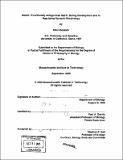| dc.contributor.advisor | Paul A. Garrity. | en_US |
| dc.contributor.author | Khodosh, Rita | en_US |
| dc.contributor.other | Massachusetts Institute of Technology. Dept. of Biology. | en_US |
| dc.date.accessioned | 2006-07-31T15:31:06Z | |
| dc.date.available | 2006-07-31T15:31:06Z | |
| dc.date.copyright | 2005 | en_US |
| dc.date.issued | 2005 | en_US |
| dc.identifier.uri | http://hdl.handle.net/1721.1/33757 | |
| dc.description | Thesis (Ph. D.)--Massachusetts Institute of Technology, Dept. of Biology, 2005. | en_US |
| dc.description | Includes bibliographical references. | en_US |
| dc.description.abstract | BEACH proteins comprise an evolutionarily conserved family characterized by the presence of a BEACH (Beige and Chediak-Higashi) domain of unknown function. They have been shown to play a role in a number of important cellular processes, ranging from cytokinesis to synaptic transmission, and implicated in human diseases, such as Chediak-Higashi Syndrome and cancer. Analysis of several BEACH proteins suggests that they may be involved in membrane trafficking; however, little insight has been gained into their molecular mechanism of function. We identified Drosophila Beach1 in a gain-of-function screen: beach1 overexpression in the photoreceptors drastically alters their growth cone morphology. In a subsequent genetic modifier screen, I identified rabll as a strong enhancer of the beach1 eye overexpression phenotype. Rabll is a small GTPase, which has been shown to regulate the delivery of vesicles and cargo to the plasma membrane via both the recycling and the biosynthetic pathways. Although beach1 loss-of-function mutants exhibit no obvious phenotypes, a sensitized background of a rabll mutant revealed a requirement for beach1 during development and in bristle extension. | en_US |
| dc.description.abstract | (cont.) I also found that Beach1 functionally antagonizes Rab11 at the neuromuscular junction by suppressing the rabll synaptic overgrowth phenotype. Subcellular fractionation and double-labeling experiments suggest that these proteins may function in the same subcellular compartment; however, further experiments are needed to determine whether Beach1 and Rab11 interact directly, function in the same protein complex, or closely cooperate in the same molecular pathway. The interaction I found between Beach1 and Rab11 suggests a mechanism by which other BEACH proteins may be involved in vesicle trafficking. | en_US |
| dc.description.statementofresponsibility | by Rita Khodosh. | en_US |
| dc.format.extent | 152 leaves | en_US |
| dc.format.extent | 8983698 bytes | |
| dc.format.extent | 8990117 bytes | |
| dc.format.mimetype | application/pdf | |
| dc.format.mimetype | application/pdf | |
| dc.language.iso | eng | en_US |
| dc.publisher | Massachusetts Institute of Technology | en_US |
| dc.rights | M.I.T. theses are protected by copyright. They may be viewed from this source for any purpose, but reproduction or distribution in any format is prohibited without written permission. See provided URL for inquiries about permission. | en_US |
| dc.rights.uri | http://dspace.mit.edu/handle/1721.1/7582 | |
| dc.subject | Biology. | en_US |
| dc.title | Beach1 functionally antagonizes Rab11 during development and in regulating synaptic morphology | en_US |
| dc.title.alternative | Beige and Chediak-Higashi one functionally antagonizes Rab11 during development and in regulating synaptic morphology | en_US |
| dc.type | Thesis | en_US |
| dc.description.degree | Ph.D. | en_US |
| dc.contributor.department | Massachusetts Institute of Technology. Department of Biology | |
| dc.identifier.oclc | 65197118 | en_US |
